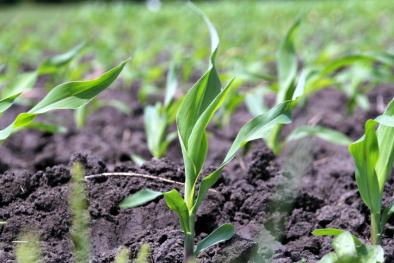November 16, 2020

As farmers across Iowa wrap up this year’s harvests, and as the year ends, thoughts turn toward next season, and what type of corn and soybean hybrids and varieties might be best in 2021.
This year saw a lot of variable weather events and patterns that occurred across the state. Between the severe drought conditions in the western half of the state and the Derecho storm that tore through the center, fields have been hit with a lot of obstacles. These obstacles will play a part in the decision making process of hybrid and variety selection for 2021.
Downed corn across Iowa is a prevalent situation with many fields being deemed unharvestable by insurance or requiring extra resources to harvest. These fields have left a much higher volume of harvest loss corn on the ground than in previous years. Selecting a soybean variety that fits your volunteer corn control program is important for 2021 to combat this. This timely article and video show some examples and ideas for dealing with downed corn and volunteer corn management for 2021.
Variable environmental conditions and increased downed corn are not the only factors to consider when making your decisions on which corn hybrids and soybean varieties to plant in 2021. The two articles listed below go into great detail on aspects of hybrid and variety selection that are critical regardless of the previous cropping year.
For 2021, however, there are a few things to highlight that may help with your decisions. The first would be understanding where your stand in relation to soil moisture in your fields. Current fall soil moisture levels are variable across the state. Parts of northwest Iowa are above 60% short or very short in top and subsoil moisture, while northeast Iowa is over 80% adequate to surplus. (USDA. NASS. Iowa Crop Progress condition 11-8-20). 
West Central Iowa experienced a prolonged severe D3 drought event in the summer with the effects lingering into the fall. These soil moisture swings may make a farmer decided to plant a hybrid or variety that has more potential for drought tolerance. Soil moisture can change and no one can predict the winter snowpack, but understanding that 2021 is starting at a deficit or a surplus helps in decisions. Drought tolerance might be more important in 2021 than previous years.
Another important factor to consider is herbicide trait packages for 2021, especially in soybeans. There could be an increase in the amount of volunteer corn in fields which could alter plans for weed control dynamics. Also, recent court cases involving Dicamba and other labeled products make it imperative you choose the correct traits for your fields. Rotating herbicides site and modes of action can be more easily managed in 2021 with more options, however these options can carry risks for environmental contamination if not placed properly. Traits and technology can help farmers be more efficient but they can also be harmful and more costly if used incorrectly.
A third issues that has been creeping up on certain Iowa farmers is the increase in resistance to Corn Rootworm Traits. These traits and proteins will eventually develop resistances and are not “bullet proof” methods of control that some people would like to believe. A proper integrated crop management system of crop and trait rotations is appropriate if you are seeing resistance issues in your fields. Corn on corn fields with multiple years of the same trait packages in high CRW pressure areas are particularly prone to failures. 2021 is a good year to get in front of these insect issues by rotating crops, switching traits or adding different insecticides to your mix. A little bit of management goes a long way in preventing resistance.
Most farmers are ready to put 2020 in the rearview mirror and move on to next season. Fields are being harvested at an increased rate over last year and farmers are soon going to be getting ready for winter and next year’s decisions. Understanding where your fields stand after 2020 and making a few small changes in management or hybrid/variety selections will help reduce the yield robbing potential this year gave us. If 2020 taught farmers anything, it is to expect the unexpected in 2021 and prepare accordingly.
Source: Iowa State University, which is solely responsible for the information provided and is wholly owned by the source. Informa Business Media and all its subsidiaries are not responsible for any of the content contained in this information asset.
You May Also Like




